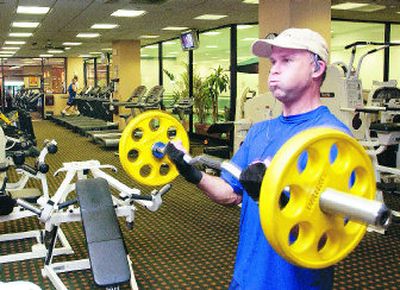Pump it up

MINNEAPOLIS – The mere mention of weightlifting generates images of people who resemble vending machines with arms. We see bodybuilders posing with clenched teeth during Mr. America contests, or we hear them grunting in a corner of the health club as they struggle to control barbells the size of Volkswagen Beetles.
But an increasing number of people are picking up weights to slim down rather than bulk up. Research has shown that lifting weights raises a person’s metabolic rate, which, in turn, increases the burning of calories.
You don’t need massive biceps to make this happen, researchers say. All it takes is a little more muscle here and a tad more muscle there.
“If you add three pounds of muscle, you’ll burn off an extra 100 calories a day,” said Bret Blount, spokesman for Nautilus Inc. “That’s an extra 100 calories without doing anything at all except your normal daily activities.”
But left to its own devices, the human body will do just the opposite.
“The average adult loses half a pound of muscle every year,” Blount said. “You don’t lose half a pound of weight; you lose half a pound of muscle. And that muscle is replaced by fat. So instead of thinking of using weights to pump up, we need to change our thinking so it’s in terms of maintaining the muscle we’ve got.”
The image of weightlifting has been skewed since the late 1950s, he said. That’s when Santa Monica’s Muscle Beach became a social curiosity-cum-tourist site and created the impression that weightlifting and bodybuilding were two terms for the same thing. Not so.
“At that point, we didn’t know anything about the cardiovascular aspects of strength training,” he said. “Bodybuilding is a function of the exercises you do and the calories you consume,” he added, noting that many bodybuilders consume extra calories in protein supplements designed to help them gain bulk.
Weightlifting is finding supporters in many corners of the health and fitness community. PubMed, an online service of the National Library of Medicine and the National Institutes of Health, reports on research showing that weightlifting enhances the bone-mineral density in women. Researchers at the University of Southern California found that weightlifting by teenagers reduces their risk of getting diabetes as they get older.
And doctors at the University of Texas are conducting a five-year study that they believe will prove that weightlifting helps prevent hardening of the arteries.
“When using free weights, start light and listen to your body,” Blount said. “Of course, that’s good advice for any exercise.
“But with weights, you also want to be sure that you know what you’re doing. If you have questions about techniques, you should get advice from a personal trainer.”
The increased interest in weightlifting has found its way to the marketplace. Blount’s company, which also is the parent company for Bowflex, has introduced an innovative dumbbell on which the weight can be adjusted with a twist of a dial. The Bowflex SelectTech Dumbbells come in three sizes: 2 to 20 pounds, 5 to 52 pounds and 10 to 90 pounds.
“Each dumbbell replaces a set of dumbbells,” he said. The goal is to create a variety of exercises in a minimum amount of space.
But you might already have what you need. A survey Nautilus conducted found that 42 percent of respondents already had free weights at home.
There is a catch, however: “You’ve got to stick with it,” Blount said. “You can’t do this for two months and then quit for two months, because you’re going to lose everything you just gained.
“You have to make it a regular part of your life.”